HTV-7 (H-II Transfer Vehicle-7 / Kounotori-7)
Non-EO
JAXA
Human Spaceflight
Quick facts
Overview
| Mission type | Non-EO |
| Agency | JAXA |
| Launch date | 22 Sep 2018 |
| End of life date | 11 Nov 2018 |
HTV-7(H-II Transfer Vehicle-7 / Kounotori-7)
Launch HTV-7 Payload HSRC Mission Mission Status References
HTV-7 will be the seventh flight of the HTV (H-II Transfer Vehicle) of JAXA (Japan Aerospace Exploration Agency), an unmanned cargo spacecraft to the ISS (International Space Station). On 28 July 2018, the HTV-7 "Kounotori-7" vehicle was unveiled to media at JAXA's Tanegashima Space Center (TNSC) along with the briefing of its upcoming mission. 1)
Overview of HTV missions: The HTV is launched from the Tanegashima Space Center aboard an H-IIB launch vehicle with up to 6,000 kg of supplies. When the HTV approaches close to the ISS, the Space Station Remote Manipulator System (SSRMS), known as "Canadarm2," grapples the HTV and berth it to the ISS. After the supplies, such as food, clothes and a variety of experiment equipment, are unloaded, the HTV will then be loaded with waste materials, including used experiment equipment or used clothes. The HTV will then undock and separate from the ISS and reenter the atmosphere. While the HTV is berthed to the ISS, the ISS crew will be able to enter and remove the supplies from the HTV Pressurized Logistics Carrier.
Length | ~ 10.0 m |
Diameter | ~ 4.4 m |
Mass of vehicle excluding cargo | ~ 10,500 kg |
Cargo capacity (supplies and equipment) | Total: 6,000 kg maximum |
Total mass | 16,500 kg maximum |
Reentry cargo capacity | 6,000 kg maximum |
Propellant | Fuel: MMH (Monomethylhydrazine) |
Insertion orbit | Altitude: 350km-460km, Inclination: 51.6 degrees |
Mission Duration | Solo flight: Normally 5 days |
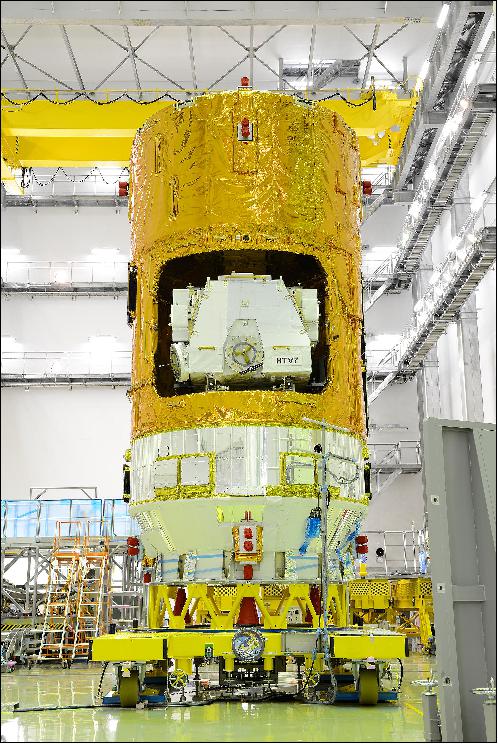
The H-II Transfer Vehicle (HTV) consists of two logistic carriers, the PLC (Pressurized Logistics Carrier ) and the ULC (Unpressurized Logistics Carrier), which also includes the EP (Exposed Pallet), as well as an Avionics Module and a Propulsion Module.
The Japanese Experiment Module (JEM), known as "Kibo," is equipped with antennas, reflectors and a Proximity Communication System (PROX) that enables inter-orbit communication with the HTV as the HTV approaches the ISS.

The PLC carries cargo such as International Standard Payload Racks (ISPRs), drinking water and clothes that will be used aboard the ISS. The PLC's internal air pressure is controlled and maintained at one atmospheric pressure (1 atm). While the HTV is berthed with the ISS, the ISS crew can enter the PLC to unload the supplies. After the supplies are unloaded, waste material will be loaded. The ISS crew members enter and exit through the HTV's berthing port that is equipped with the Common Berthing Mechanism (CBM).
The ULC carries unpressurized cargo loaded on the Exposed Pallet (EP).
The Avionics Module contains navigational and electrical systems used for HTV's navigation control, communication and supplying power. The Avionics Module enables the HTV flight to navigate by receiving commands sent from the ground or to navigate by HTV autonomous flight systems. In addition, the Avionics Module distributes power to each of its components.
The Propulsion Module has four propellant tanks. The HTV's thrusters generate propulsion for orbital adjustment or attitude control. There are 32 thrusters installed on the HTV.
The Proximity Communication System (PROX), which is installed on Kibo, consists of a PROX antenna, a PROX-GPS antenna, PROX communication equipment and a Hardware Command Panel (HCP). With the exception of the PROX antenna, the PROX-GPS antenna and the HCP, the PROX is installed in the JEM Pressurized Module.
When the HTV approaches close to the ISS, the PROX antenna initiates communications with the HTV. This antenna contains GPS receivers. Through the PROX, the ISS's orbital location and speed are immediately relayed to the HTV. At the same time, data from the HTV are relayed to the ISS. In addition, the antenna relays commands sent from the ground to the HTV.
The reflectors are installed on the nadir (bottom) side of Kibo. The reflectors reflect the lasers that are beamed from the HTV's Rendezvous Sensor (RVS) during the HTV close proximity operation.
Launch
The HTV-7 (H-II Transfer Vehicle-7) "Kounotori-7" of JAXA, with a total of 6200 kg of cargo, was launched aboard the H-IIB F7 vehicle of MHI ( Mitsubishi Heavy Industries, Ltd.) on 22 September 2018 (17:52:27 UTC / 02:52:27 hours JST 23 September). The launch site was the Yoshinobu Launch Complex at the JAXA TNSC (Tanegashima Space Center), Japan. - The H-IIB F7 flight proceeded nominally. Approximately 14 minutes 59 seconds after launch, as planned, the payload separated from the launch vehicle. - The cargo vessel is scheduled to arrive at the ISS on 27 September. 2)
HTV-7 was originally scheduled to take flight Sept. 10, but that liftoff was canceled because Typhoon Mangkhut was forecast to bring terrible weather to Guam, where a key JAXA tracking station is located. Bad weather around Tanegashima and an issue with the freighter's rocket conspired to delay the liftoff until today.
Orbit: Near-circular orbit of the ISS, altitude of ~400 km, inclination = 51.6º, period of ~ 93 minutes.
HTV-7 Payload
HTV-7 delivers a total of 6.2 metric tons of cargo to the ISS, including 4.3 metric tons in the PLC (Pressurized Logistic Carrier ) and 1.9 metric tons on the ULC (Unpressurized Logistic Carrier).This Kounotori-7 flight is planned to test a new reentry capsule, HSRC (HTV Small Reentry Capsule), developed at JAXA. 3)
Cargo in the PLC (Pressurized Logistic Carrier)
• Two US experiment racks (Express Rack 9B and 10B). The US EXPRESS Racks 9B and 10B will be delivered on this flight. These two EXPRESS Racks are modified for more simple interfaces.
• US Life Sciences Glovebox (LSG): The second ISS large-scale glovebox for scientific experiments, will be installed on board "Kibo".
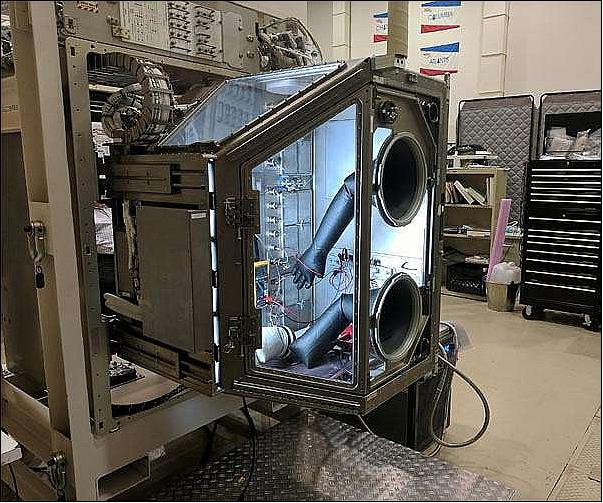
The research facility is 26 inches high, 35 inches wide and 24 inches deep, with a 15-cubic-foot workspace. It will enable researchers to conduct new experiments studying the effects of microgravity on the human body - aiding deep space exploration missions into the solar system.
• LSR (Life Support Rack): The LSR, developed by ESA, is equipment for demonstration test of effective life support system which produces oxygen (O2) from water (H2O) by using electrolysis and also converts the produced hydrogen (H2) in Sabatier reaction with carbon dioxide (CO2), removed from the inside of the cabin, into methane (CH4) and byproduct water (H2O), which is then recycled for electrolysis.
- The rack, also known as ACLS (Advanced Closed Loop System) has been developed by Airbus for ESA as a technology demonstrator, which will purify air and produce oxygen for the ISS. The rack will be installed into the Destiny Module (US Laboratory) by ESA astronaut and ISS commander Alexander Gerst on 2 November 2018. Its technology is a critical step forward towards a closed loop life support system, necessary for human spaceflight beyond low Earth orbit. 5)
- A newly formed ACLS operations team (OPS), based at Airbus in Friedrichshafen, Germany, will operate the ACLS throughout its mission. ACLS OPS is part of the ISS's ground network, and works directly with the ESA Columbus Control Center in Oberpfaffenhofen, Germany.
- Following installation, the ACLS OPS team will commence a six week commissioning phase to check the new facility. Successful commissioning will be followed by operations on the ISS until the end of 2019, with the ACLS providing additional carbon dioxide removal and oxygen generation capabilities to the astronauts onboard.
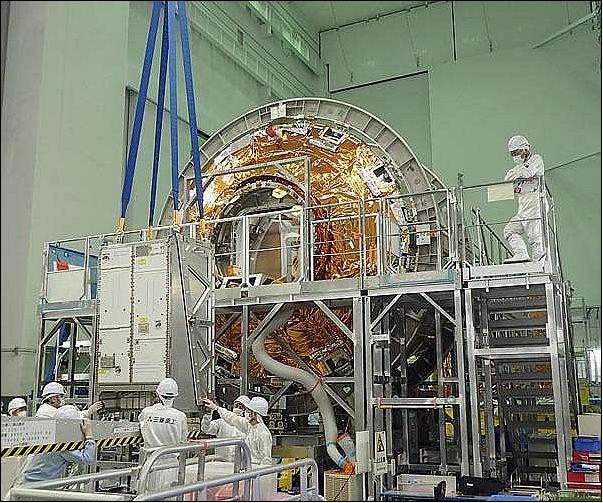
• HSRC (HTV Small Reentry Capsule): The HSRC will demonstrate the newly dveloped reentry technology and cargo recovery function from the ISS. The HSRC, including experiment samples, will be attached to the hatch of the PLC (Pressurized Logistic Carrier) before the HTV-7 unberthing from ISS. HSRC will be separated from the HTV-7 after its deorbit burn; reenter Earth's atmosphere; descend by parachute; and be recovered after splashdown (Figure 7). 6)
- In the HTV-7 mission, after completing the re-supply mission to ISS, HTV-7 will demonstrate the novel technology for recovering experiment samples from ISS, which Japan has not obtained up until now, by taking advantage of the opportunity of reentry into Earth with the HSRC that will be loaded on the HTV for the first time ever.
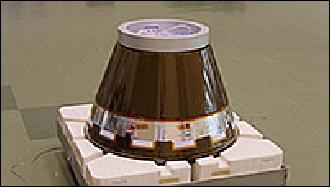
• Loop Heat Pipe Radiator (LHPR) technology demonstration system: The LHPR is expected for high efficiency heat rejection technology for future spacecraft. This LHPR demonstration will perform on-orbit technology demonstration of an expansion-type radiator equipped with a loop heat pipe by using "Kibo" as a test bed environment. — The demonstration aims to reduce risks in satellite development by reflecting the results obtained by the on-orbit demonstration to the design of the expansion-type radiator, which will be applied to Engineering Test Satellite-9 aimed at the realization of next-generation geostationary communications satellites.
• J-SSOD (JEM Small Satellite Orbital Deployer) and CubeSats: This mission will mark the 10th CubeSat deployment system, using the J-SSOD since 2012.
• CubeSats: HTV-7 will deliver the following CubeSats developed by a joint team of Nanyang Technological University (NTU, in Singapore) and Kyushu Institute of Technology ("Kyutech", in Japan), general incorporated association Rymansat Spaces, and Shizuoka University.
- SPATIUM-I (Space Precision Atomic-clock TIming Utility Mission-I) of the Kyushu Institute of Technology (Japan)/Nananyang Technological University , Singapore. The 2U CubeSat will perform a mission to demonstrate technology aimed at electron density measurement and three-dimensional mapping of ionosphere and using an ultra-small CASC (Chip Scale Atomic Clock) for CubeSats.
- RSP-00 (Ryman Satellite Project): The 1U CubeSat will perform a mission to demonstrate technology aimed at electron density measurement and three-dimensional mapping of ionosphere and chip scale (ultra-small) atomic clock for CubeSats.
- STARS-Me (Shizuoka University): Two 1U CubeSats will perform a small-scale demonstration of a space elevator, which is a demonstration mission of configuration of two satellites and a climber (moving mechanism). — The test involves a miniature elevator stand-in — a box just 6 x 3 x 3 cm in size. If all goes well, it will provide proof of concept by moving along a 10 m cable suspended in space between two CubSats that will keep it taut. The mini-elevator will travel along the cable from a container in one of the CubeSats. The movement of the motorized "elevator" box will be monitored with cameras in the CubeSats. 7)
• Fresh food: Following HTV-5 and HTV-6, HTV-7 will also deliver food and other supplies including fresh food.
Cargo on the ULC (Unpressurized Logistic Carrier)
• Following the HTV-6, the HTV-7 (and also HTV8 and HTV9) will deliver new lithium ion batteries for the ISS on the Exposed Pallet (EP) on the ULC. New six battery ORUs (Orbital Replacement Units), consisting of new lithium-ion battery cells, manufactured by a Japanese company, are delivered.
- The nickel-hydrogen batteries currently used on the ISS are becoming old. The extension of ISS operations becomes possible with the supply of Japanese lithium-ion battery cells. Only the HTV is capable of delivering six battery ORUs at one time, and thus plays an important role in continuous ISS operations.
- Since the station is often not in direct sunlight, it relies on rechargeable batteries to provide continuous power during the "eclipse" part of the orbit (35 minutes of every 90 minute orbit). The batteries ensure that the station is never without power to sustain life-support systems and experiments. During the sunlit part of the orbit, the batteries are recharged.

HSRC (HTV Small Reentry Capsule) Mission
The HSRC with experiment samples on board will be attached onto the hatch of the Pressurized Logistic Carrier (PLC) of the HTV-7 before the HTV-7 departs (un-berthed) from ISS. After the HTV-7 deorbit burn finished, the capsule will be released from the PLC by the command from the ground and reenter into Earth's atmosphere, and subsequently descend on a parachute. The capsule will be recovered from the ocean after splashdown.
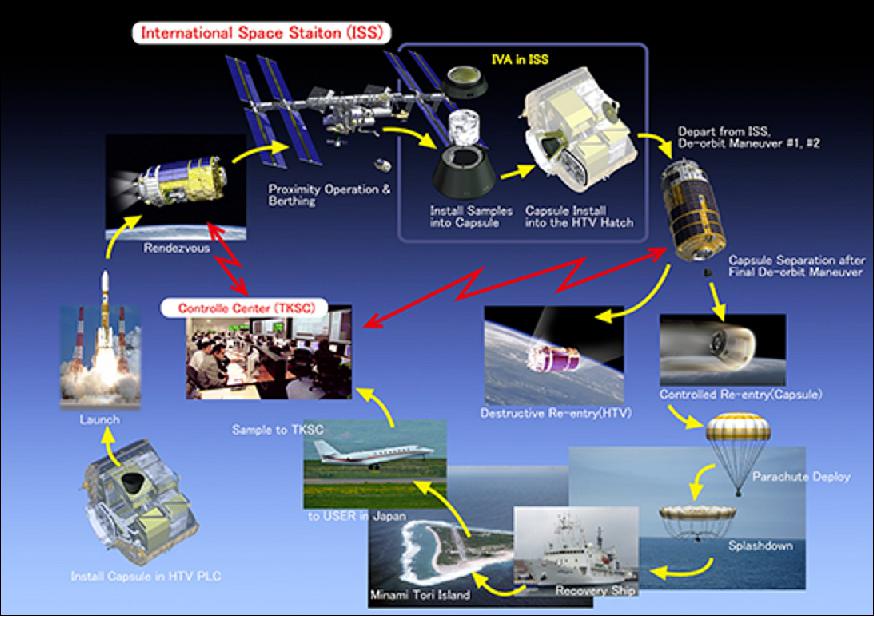
HSRC and its Payload Container Overview
The HSRC on board HTV-7 "Kounotori-7", where samples will be kept cool in a passive way (no electric cooler), houses a vacuum double layer insulation container (thermos bottle) and a heat storage unit (refrigerant), inside of which experiment samples will be stored.

Installation of the Reentry Capsule
Before the HTV-7 departs from the ISS, the crew will load an HSRC-exclusive structure (cylindrical support) onto the hatch at the entry of the Pressurized Logistic Carrier for air tightness (while the hatch of the HTV-7 is left open). The HSRC with the separation mechanism attached will be fixed onto the structure.
After completing the de-orbit maneuver, the HTV-7 will operate the separation mechanism of the HSRC according to the command received from the ground to separate the HSRC from the vehicle.

The HSRC will reenter Earth's atmosphere in a guided lift flight, deploy a parachute, and splash down into the sea, which in turn be picked up by a recovery ship. Experiment samples taken out from the HSRC will be loaded onto an airplane on Minamitori Island, immediately delivered to the mainland of Japan (the HSRC itself will remain aboard the recovery ship to be delivered to the mainland).
Mission Status
• November 11, 2018: The H-II Transfer Vehicle "KOUNOTORI-7" (HTV-7) successfully re-entered the atmosphere after the third de-orbit maneuver at 6:14 a.m. on November 11, 2018 (Japanese Standard Time, JST).-The "KOUNOTORI7" has successfully accomplished its main objective to ship cargo to the International Space Station (ISS). 8)
- JAXA's President, Hiroshi Yamakawa thanked all parties involved in the mission.
- In his address, Hiroshi Yamakawa said: "Momentarily, we will be recovering the HTV Small Re-entry Capsule after its splashdown in the ocean. Towards the goal to acquire Japan's first cargo recovery capacity from the ISS, the Small Re-entry Capsule will be demonstrating its guided lift flight capabilities that will enable the capsule to descent under reduced G-forces, as well as its heat protection capability of the ablator while its re-entry into the atmosphere. We expect that these efforts will lead to securing flexibility in our future space flight activities.
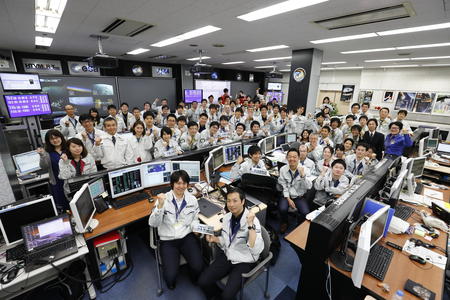
• November 8, 2018: The HTV-7/Kounotori-7 was unberthed from the nadir port of Harmony (Node 2) by the SSRMS at 8:32 p.m., November 7 (JST). 9) A southward re-entry is scheduled for November 11, 2018.
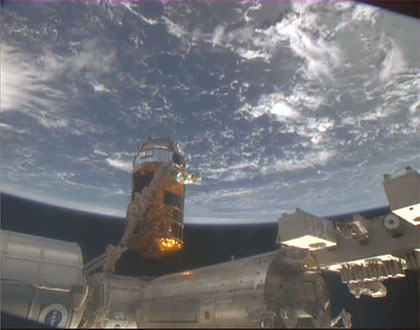
• September 28, 2018: The HTV-7/Kounotori-7 started its final approach to the International Space Station (ISS), and was captured by the ISS robotic arm at 20:36 p.m. on September 27 (Japanese Standard Time, JST) corresponding to 11:36 UTC . Being captured and maneuvered by the robotic arm, the HTV-7 was successfully berthed to the ISS at 1:08 a.m. on 28 September (JST) corresponding to 16:08 UTC on 27 September.
- Using Canadarm2 of the ISS, Expedition 56 Commander Drew Feustel and Flight Engineer Serena Auñón-Chancellor of NASA grappled JAXA's Kounotori-7/HTV-7 (H-II Transfer Vehicle). Next, robotic ground controllers installed HTV-7 on the Earth-facing side of the Harmony module. 11)
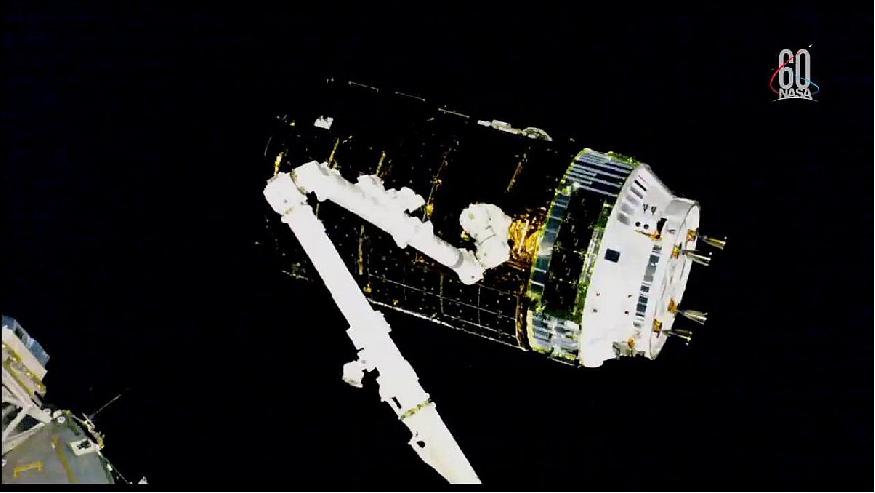
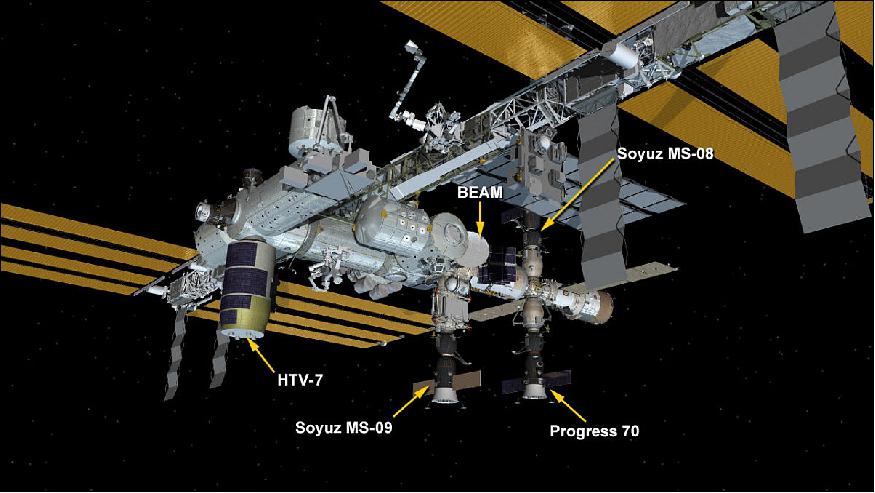
References
1) "HTV7 media briefing at Tanegashima Space Center," JAXA, 5 September 2018, URL: http://iss.jaxa.jp/en/htv/mission/htv-7/news/180728_htv7_unveil.html
2) "Launch Results of the H-II Transfer Vehicle KOUNOTORI-7 aboard the H-IIB Vehicle No. 7," JAXA Press Release, 23 September 2018, URL: http://global.jaxa.jp/press/2018/09/20180923_h2bf7.html
3)"HTV-7 Payload," JAXA, 5 September 2018, URL: http://iss.jaxa.jp/en/htv/mission/htv-7/payload/
4) "Partnership, Teamwork Enable Landmark Science Glovebox Launch to Space Station," Space Daily, 25 September 2018, URL: http://www.spacedaily.com/reports/Partnership_Teamwork
_Enable_Landmark_Science_Glovebox_Launch_to_Space_Station_999.html
5) "Airbus-built ACLS Life Support Rack is ready for launch from Tanegashima," Space Daily, 6 September 2018, URL: http://www.spacedaily.com/reports/Airbus_built_ACLS_Life_Support
_Rack_is_ready_for_launch_from_Tanegashima_999.html
6) "HTV Small Re-entry Capsule," JAXA, 5 September 2018, URL: http://iss.jaxa.jp/en/htv/mission/htv-7/hsrc/index.html
7) "Going up! Japan to test mini 'space elevator'," Space Daily, 4 September 2018, URL: http://www.spacedaily.com/reports/Going_up_Japan_to_test_mini_space_elevator_999.html
8) "Successful re-entry of H-II Transfer Vehicle "KOUNOTORI7" (HTV7)," JAXA Press Release, 11 November 2018, URL: http://global.jaxa.jp/press/2018/11/20181111_kounotori7.html
9) "Kounotori-7 was unberthed from the nadir port of Harmony (Node 2) by the SSRMS," JAXA, 8 November 2018, URL: http://iss.jaxa.jp/en/htv/news/htv7_unberthed.html
10) "Successful berthing of the H-II Transfer Vehicle "KOUNOTORI7" (HTV7) to the International Space Station (ISS)," JAXA, 28 September 2018, URL: http://global.jaxa.jp/press/2018/09/20180928_h2bf7.html
11) Marc Garcia, "U.S. Astronauts Capture Japanese Spaceship Loaded With Cargo," NASA, 27 September 2018, URL: https://blogs.nasa.gov/spacestation/2018/09/27/
u-s-astronauts-capture-japanese-spaceship-loaded-with-cargo/
12) Mark Garcia, "Japan's Kounotori Spaceship Attached to Station," NASA, 27 September 2018, URL: https://web.archive.org/web/20200229051521/https://blogs.nasa.gov/spacestation/2018/09/27/japans-kounotori-spaceship-attached-to-station/
The information compiled and edited in this article was provided by Herbert J. Kramer from his documentation of: "Observation of the Earth and Its Environment: Survey of Missions and Sensors" (Springer Verlag) as well as many other sources after the publication of the 4th edition in 2002. - Comments and corrections to this article are always welcome for further updates (eoportal@symbios.space).
Launch HTV-7 Payload HSRC Mission Mission Status References Back to top